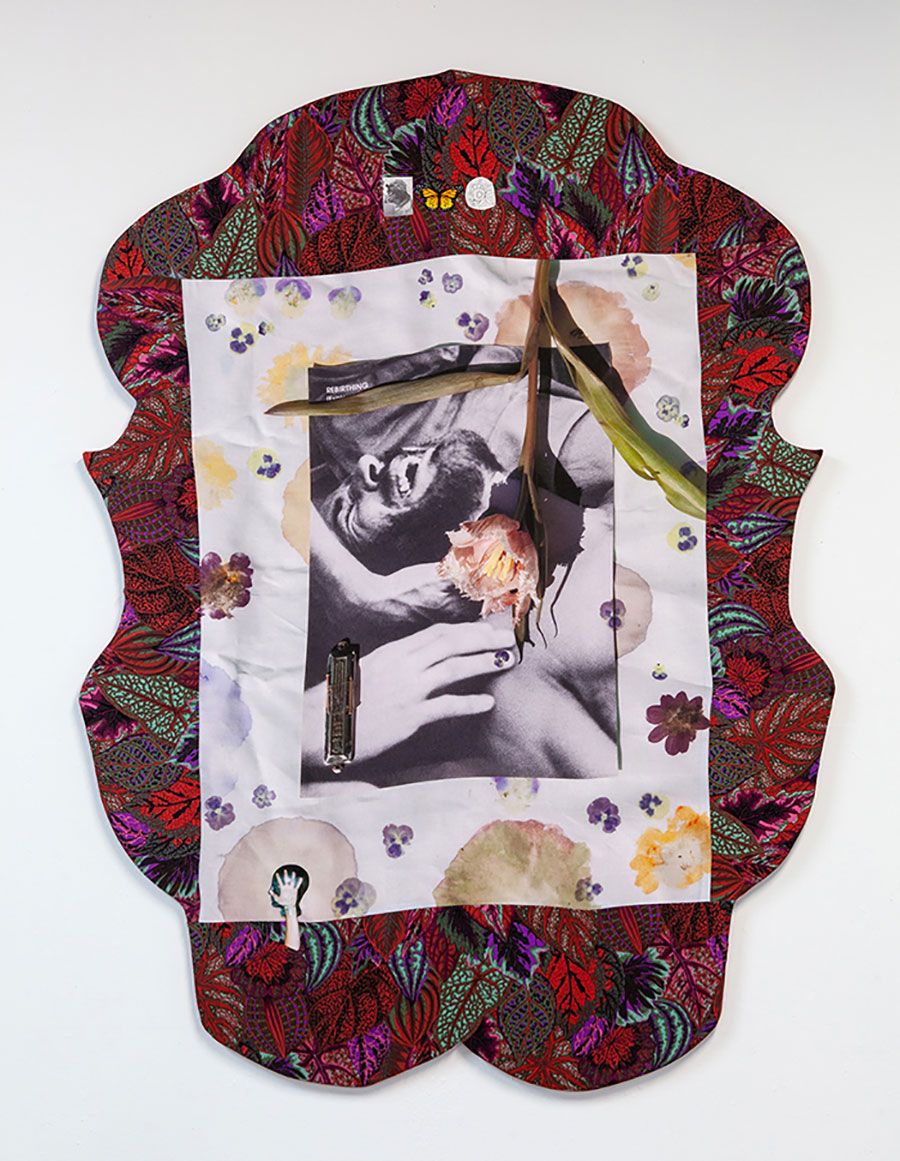Erin Jane Nelson, frieze issue 210

April 2020 Issue 210 of frieze
This review appeared in the April 2020 issue of frieze:
At Chapter, New York, collages on canvas and ceramic fuse references to Jewish mysticism and the history of craft
In Erin Jane Nelson’s solo exhibition at Chapter, five shaped, fabric-wrapped panels hang on mint green walls, encircling two ceramic vessels in the centre of the small, rectangular room. The ceramics are glazed and fired pinch pots studded with fungal-shaped growths, sitting atop white pedestals. Most of the panels are similarly covered in collaged images and shellacked with resin or epoxy: photographs of plants intermingle with pictures of men and women engaging in various spiritual activities, cartoons of mothers and their children, or black and white images of windowpanes. The panels and ceramics act as backdrops upon which Nelson attempts to establish connections between the natural world and the various cultural and religious orders we impose upon it.
 Erin Jane Nelson, Av, 2019, cotton pigment print, natural dyes, found photographs, and found fabric on panel, 1.6 × 1.2 m. Courtesy: the artist and Chapter, New York
Erin Jane Nelson, Av, 2019, cotton pigment print, natural dyes, found photographs, and found fabric on panel, 1.6 × 1.2 m. Courtesy: the artist and Chapter, New YorkThe show’s title, ‘Shekinah’, is a Hebrew word with both theological and secular connotations. Half of the works on display (all 2019) are similarly titled after other biblical or ceremonial allusions, such as Av (father), Mikveh Melt (a ritualistic bath) and Beltane (a Celtic spring festival). Shekinah can mean dwelling or can refer to a divine light that emanates from a figureless God (a singular, masculine omnipresence in Judaism). Nelson’s works, in contrast, include many figures, mostly women, performing rites and rituals traditionally assigned to men: wrapping tefillin straps around their arms, reading Torah, wearing a prayer shawl and leading services.
 Erin Jane Nelson, Well 2, 2019, found figurines, photographs, and resin on glazed stoneware. Courtesy: the artist and Chapter, New York
Erin Jane Nelson, Well 2, 2019, found figurines, photographs, and resin on glazed stoneware. Courtesy: the artist and Chapter, New YorkDeveloped over several years, Nelson’s shaped panels and unfired ceramics highlight different aspects of her identity: her relationship with her mother, teenage selfies and photos of the environment formed constellations within earlier series, and remain leitmotifs in ‘Shekinah’. The exhibition’s central panel, Matriline, is stained with natural pigments and epoxy and covered in archival photos, pounded flowers and a cyanotype of a small, decorative ornament. Along with Av, it is the clearest homage to the artist Miriam Schapiro, whose ‘femmage’ approach to elevating craft and decoration to the status of fine art served as inspiration for the Pattern and Decoration movement. Deeply kitsch, chintzy found fabric in a 1980s palette of dark reds, purple and black stretches over the symmetrical, organically shaped frame of Av; at its centre, a square of white fabric has been collaged with a photograph of a man’s nude supine bust as he throws his bearded chin back in apparent ecstasy at the touch of anonymous hands, reaching into the frame to caress his shoulder. A mezuzah – an ornament that contains a prayer and marks the doors of Jewish homes – is placed over the wrist of one of the hands, like a bracelet. Above the white fabric, three images are collaged onto the leaf-patterned background like hieroglyphics: a profile of person wearing tefillin, a butterfly and a drawing of a snail.
 Erin Jane Nelson, The Matriline, 2019, cotton pigment print, Hapa Zome, cyanotype, silver gelatin print, found photographs, mat board, natural dyes, eco epoxy, and found fabric on panel, 1.4 × 1.2 m. Courtesy: the artist and Chapter, New York
Erin Jane Nelson, The Matriline, 2019, cotton pigment print, Hapa Zome, cyanotype, silver gelatin print, found photographs, mat board, natural dyes, eco epoxy, and found fabric on panel, 1.4 × 1.2 m. Courtesy: the artist and Chapter, New York Schapiro used collotypes and patterns to call attention to the anonymous and unacknowledged contributions of women to art throughout history. Today, her work is not only institutionally sanctioned as part of the art-historical canon but – along with that of feminist peers such as Judy Chicago – has gained mainstream significance following the cultural turn towards feminism of the post-2016 #MeToo era. To take a similar approach today is far less transgressive and requires an adept handling of materials to build on the language that Schapiro and others spearheaded. What does it mean to make work within this aesthetic tradition today, and how do religion and ritual relate to the subject of décor and the elevation of craft to the realm of fine art? ‘Shekinah’ searches towards such a language to speak about the divine but remains caught in the material realm.
